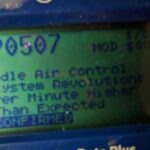Experiencing trouble reading diagnostic codes from your 2002 Ford Windstar? A frustrating “OBDII code error” or a complete lack of communication with your scan tool can leave you in the dark about your minivan’s health. This guide, drawing upon real-world experiences and expert advice, will help you pinpoint the reasons behind this issue and get you back on the road to diagnosing and resolving your vehicle’s problems.
Many Ford Windstar owners have encountered situations where their OBDII scanner fails to connect, preventing them from accessing crucial error codes. This communication breakdown can stem from several potential sources, ranging from simple fixes to more complex component failures. Let’s explore the common culprits and how to systematically troubleshoot them.
One of the most frequent and easily overlooked causes of OBDII communication failure is a blown fuse. The On-Board Diagnostics system, or OBDII, relies on a dedicated fuse to power its diagnostic port. If this fuse is blown, your scanner will not receive power, and communication will be impossible.
The most commonly reported fuse related to the OBDII port in the 2002 Ford Windstar is fuse #17. Located within the fuse box, this fuse is often responsible for powering not only the diagnostic link connector (DLC), but also other systems in your vehicle.
Checking Fuse #17 is the first and simplest step in diagnosing an OBDII communication error. You can typically locate the fuse box either under the dashboard on the driver’s side or under the hood. Refer to your Ford Windstar owner’s manual for the precise location of the fuse box and the fuse diagram.
To inspect the fuse, you will need to:
- Locate the fuse box: Consult your owner’s manual for its exact placement.
- Identify fuse #17: Use the fuse box diagram to find fuse #17, often labeled for “diagnostic link connector” or similar.
- Visually inspect the fuse: Look for a broken filament within the fuse. If the thin wire inside is melted or broken, the fuse is blown.
- Test with a test light or multimeter: For a more definitive check, use a test light or multimeter to confirm if power is flowing through the fuse terminals. No power indicates a blown fuse.
If fuse #17 is indeed blown, replace it with a fuse of the same amperage rating. It is crucial to use the correct amperage to prevent further electrical issues. After replacing the fuse, attempt to connect your OBDII scanner again. If communication is restored, the blown fuse was the likely culprit.
However, if replacing the fuse doesn’t solve the problem, or if the fuse blows again immediately, it indicates a more serious underlying issue. One potential cause, as highlighted by experiences shared by Ford Windstar owners, is a problem with the Powertrain Control Module (PCM).
The PCM is the central computer of your engine management system. It controls various engine and transmission functions, and importantly, it is responsible for communicating diagnostic data through the OBDII port. If the PCM itself is faulty or not receiving power, it can lead to a “no communication” error with your scan tool.
Symptoms of a failing PCM can extend beyond OBDII communication issues and may include:
- Check Engine Light (CEL) illumination: While a CEL can indicate many problems, a PCM issue can also trigger it.
- Engine performance problems: Rough idling, stalling, misfires, or lack of power can be signs of PCM malfunction.
- Transmission issues: Erratic shifting or transmission warning lights may appear.
- Other electrical malfunctions: Problems with systems controlled by the PCM, such as air conditioning or cruise control, could occur.
- “Fuel Computer Data Error” or “Charge System Data Error” messages: These specific messages, as reported by Windstar owners, can also point to PCM problems.
Diagnosing a faulty PCM typically requires professional expertise and specialized diagnostic tools. While some DIYers have successfully replaced PCMs themselves, it’s important to understand that PCM replacement often requires reprogramming to match your specific vehicle’s VIN and options. Attempting to replace the PCM without proper knowledge or equipment can lead to further complications.
If you’ve checked fuse #17 and are still experiencing OBDII communication errors, and especially if you are observing other symptoms suggestive of PCM issues, it is highly recommended to seek professional diagnosis from a qualified mechanic. They can use advanced scan tools to further investigate the communication problem, test the PCM, and determine the most appropriate course of action.
In some cases, wiring problems or issues with the OBDII port itself can also contribute to communication failures. However, these are less common than fuse or PCM related issues. A mechanic can thoroughly inspect the wiring and the OBDII port to rule out these possibilities.
In conclusion, when faced with a “2002 Ford Windstar Obdii Code Error” or no communication with your scan tool, prioritize these troubleshooting steps:
- Check Fuse #17: This is the most common and easiest fix. Replace it if blown, ensuring you use the correct amperage.
- Consider PCM Issues: If the fuse is not the problem, suspect a potential PCM malfunction, especially if accompanied by other engine or electrical symptoms.
- Seek Professional Diagnosis: For PCM related issues or if you are unsure, consult a qualified mechanic for accurate diagnosis and repair.
By systematically following these steps, you can effectively troubleshoot OBDII communication problems in your 2002 Ford Windstar and get your vehicle diagnosed and repaired efficiently.

